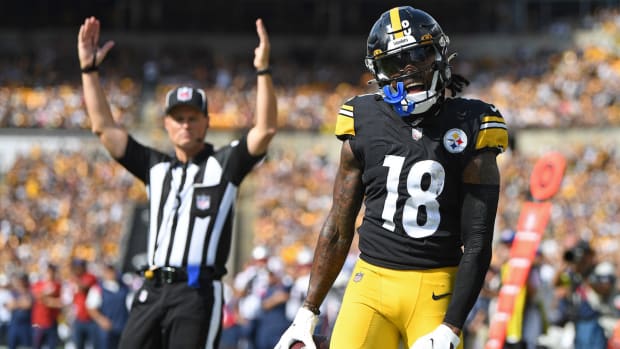Why C.J. Anderson Is a Better Fit for the Rams' Offense Than Todd Gurley Right Now
ATLANTA—Walking into the tunnel at halftime in Week 16 at Arizona, Rams veteran center John Sullivan pulled aside C.J. Anderson, who had signed just days earlier, and asked the one question that has followed the soon-to-be 28-year-old running back since: “How on Earth were you available!?”
Anderson’s cliff-noted answer: He was wedged out by younger (cheaper) running backs in Denver, never got on the field in Carolina thanks to Christian McCaffrey playing 91.3 percent of the snaps and was sacrificed after just one week in Oakland when injuries demanded reinforcements along the offensive line.
The Rams only signed Anderson because, with No. 2 tailback Malcolm Brown seriously injuring his clavicle in Week 13 at Detroit, they eventually needed someone to fill in while Todd Gurley nursed a knee injury in Weeks 16 and 17. Not a soul would have guessed Anderson could play well enough to supplant Gurley, who over the summer signed a deal worth $45 million guaranteed. But in the NFC Championship, that’s exactly what happened.
ROSENBERG: Ndamukong Suh Remains One of a Kind on Biggest Stage of His Career
The Rams insist Gurley’s injured right knee is healed, and recall that in his first game back—the divisional round stomping of Dallas—he looked vibrant, rushing for 115 yards on 16 carries. (For what it’s worth, Anderson that night had 123 yards on 23 carries.)
There’s an explanation for L.A.’s unlikely shift in backfield power: Gurley might be the more talented all-around player, but stylistically, Anderson is the better schematic fit. The Rams employ a classic outside zone running scheme. On outside zone runs, a ballcarrier directs his run toward the perimeter, but with the hope that he’ll find an inside cutback lane along the way. Anderson is great at spotting and exploiting those cutback lanes. He runs low to the ground with keen vision and deceptively loose hips, which allow him to work through small cracks and elude defenders within confined areas.
Gurley, on the other hand, is a higher-velocity runner but with buildup speed. His top gear bests Anderson’s by several notches, but it takes Gurley longer to reach that top gear. (This is why he’s more feared running outside than inside; outside runs take longer to develop.) Gurley also has tighter hips. This isn’t to say he’s stiff, but fluid change-of-direction has never been his forte. Consider the entirety of Gurley’s traits and it’s easy to understand why he’s more feared as an outside runner than inside runner. Outside runs lend more time for building velocity.
The problem is, outside runs are not consistently available in the NFL. They’re especially not available against the Patriots, who put a premium on setting the edge. When you set the edge properly, the widest-aligned line of scrimmage defender acts as a wall that forces the ball to stay inside. When asked this week, “Besides setting the edge, what’s the biggest key for you guys stopping the outside zone run game?” Patriots defensive lineman Trey Flowers still instinctively answered “setting the edge.”
BENOIT: For the Rams to Win, They’ve Got to Stifle the Run—and That Inside Pass
Flowers told me the same thing about L.A.’s ground game as dozens of other players this week: the Rams call the same plays for Gurley and Anderson, but those plays pan out differently because the two are such different runners.
Typically what keeps a recently-signed running back from vaulting to the top of the depth chart is pass protection. It can be difficult to pick up an offense’s blocking rules, and the consequences for not picking them up terrifies offensive coaches.
But “we’re in our first pressure meeting and it was very clear from the start that C.J. had a lot of thoughts on protection,” Sullivan said. “He had opinions, he was willing to communicate them, he was willing to listen to other people, listen to how we see it in our system. Go back to the Arizona game. Look at the job he did without the ball in his hands. He was amazing right from the start.”
In the other phase of the passing game—receiving—Anderson is not as threatening as Gurley, but this season Gurley himself has not quite been as threatening as he was a year ago. His receiving yards have dropped from 52 per game to 41, as the Rams have not featured him on designer backfield screens as aggressively as last year. That’s almost certainly an unintended byproduct of this offense’s evolution, not a philosophical shift from Sean McVay. But however it shakes out, Los Angeles’s passing game has become subtly less dependent on Gurley.
KLEMKO: For the Rams’ Dante Fowler, a Midseason Trade, and a Career Rebirth
Anderson has praised McVay and L.A.’s staff for putting players in position to succeed. “They’re not asking us to do something we have not done or maybe can’t do,” he said. “They’re not even testing those waters.” Anderson also said this week, “This is Todd’s football team.”
Long-term, yes. But don’t be surprised if this Sunday it again looks more like C.J.’s.
• Question or comment? Email us at talkback@themmqb.com.




































